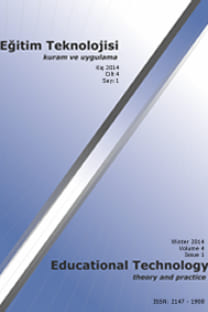AŞIRMACILIĞIÖNLEMEVEAKADEMİKDÜRÜSTLÜĞÜSAĞLAMADATURNİTİN KULLANIMINAİLİŞKİNÖĞRENCİGÖRÜŞLERİNİNİNCELENMES
EXAMININGSTUDENTS'VİEWSONTHEUSEOFTURNİTİN TOPREVENTPLAGIARISMANDSUPPORTACADEMİCHONESTY
___
- Batane, T. (2010). Turning to Turnitin®to Fight Plagiarism among University Students. Educational Technology & Society, 13(2), 1--12.
- Betts, L. R., Bostock, S. J., Elder, T. J.,& Trueman, M. (2012). Encouraging good writing practice in first--year Psychology students: An intervention using Turnitin®. Psychology Teaching Review, 18(2), 74--81.
- Carbone, N. (2001). Turnitin®.com: A Pedagogic Placebo for Plagiarism. TechNotes, http://bedfordstmartins.com/technotes/techtiparchive/ttip060501.htmadresinden 21 Şubat 2014 tarihinde erişilmiştir.
- Carroll, J. (2002).A handbook for deterring plagiarism in higher education. Oxford: Oxford Centre for Staff and Learning Development.
- Cohen, J. (2010). Using Turnitin®as a formative writing tool.Journal of Learning Development in Higher Education, (2).
- Dahl, S. (2007). Turnitin®®: The student perspective on using plagiarism detection software. Active Learning in Higher Education, 8(2), 173--191.
- Demiraslan Çevik, Y., İltüzer, Y., & Barın, S. (Nisan 2014). Aşırmacılığı Önlemede Turnitin®Kullanımına İlişkin Öğrenci Bakış Açılarının İncelenmesi.[Bildiri]International Conference on New Trends in Educational Technology (INTET2014),
- Famagusta, Kıbrıs.Fraenkel, J. R. & Wallen, N. E. (2003). How to design and evaluate research in education (5th ed.). Boston: McGraw Hill.
- Guader, H. (2004). The Hunt for Plagiarism. Internet Reference Services Quarterly, 8(4), 27--41.
- Hill, J. D. & Page, E. F. (2009). An Empirical Research Study of the Efficacy of Two Plagiarism--Detection Applications. Journal of Web Librarianship, 3(3), 169--181.International Center for Academic Integrity (2014).http://www.academicintegrity.org/icai/home.phpadresinden 20 Mart 2014 tarihinde erişilmiştir.
- Jenson, J. & De Castell, S. (2004). 'Turn it in': technological challenges to academic ethics. Education, Communication & Information, 4(2--3), 311--330.
- Ledwith, A. & Risquez, A. (2008). Using anti--plagiarism software to promote academic honesty in the context of peer reviewed assignments. Studies in Higher Education, 33(4), 371--384.
- Park, C. (2003). In Other (People's) Words: Plagiarism by University Students --Literature and Lessons. Assessment and Evaluation in Higher Education, 28(5), 471--488.
- Renard, L. (2000). Cut and paste 101: Plagiarism and the net. Educational Leadership, 57(4), 38--42.
- Rolfe, V. (2011). Can Turnitin®be used to provide instant formative feedback? British Journal of Educational Technology, 42(4), 701--710.
- Selwyn, N. (2008). 'Not necessarily a bad thing': a study of online plagiarism amongst undergraduate students. Assessment and Evaluation in Higher Education, 33(5), 465--479.
- Stappenbelt, B., Rowles, C. & May, E. (2009). Cultural influence on attitudes to plagiarism.InTeaching and learning for global graduates.Proceedings of the 18th Annual Teaching Learning Forum, 29--30 January 2009. Perth: Curtin University of Technology. http://otl.curtin.edu.au/tlf/tlf2009/refereed/stappenbelt.html
- Szabo, A. & Underwood, J. (2004). Cybercheats: Is Information and Communication Technology Fuelling Academic Dishonesty? Active Learning in Higher Education, 5(2), 180--199.
- Underwood, J. & Szabo, A. (2003). Academic Offences and E--learning: Individual Propensities in Cheating. British Journal of Educational Technology, 34(4), 467--77.
- Wilson, R. (1999). Colleges urged to better define academic integrity and to stress its importance. Chronicle of Higher Education, 46(8), p. A18.
- ISSN: 2147-1908
- Yayın Aralığı: Yılda 2 Sayı
- Başlangıç: 2011
- Yayıncı: Tolga Güyer
Özcan AKGÜN, Ömer GÖKMEN, Ebru ALBAYRAK ÖZER, Zeliha DEMİR KAYMAK, Mehmet HORZUM, Mübin KIYICI
Yasemin DEMİRASLAN ÇEVİK, Sibel BARIN
KİŞİSELLEŞTİRİLMİŞ MATEMATİK PROBLEMLERİNİN AKADEMİK BAŞARIYA ETKİSİ
SANALORTAMLARDABİREYLERİNGÜVENİRLİĞİNİNİNTERNETBAĞIMLILIKDURUMLARINAGÖREİNCELENMESİ
Yasemin DEMİRASLAN ÇEVİK, Sibel BARIN
SANAL ORTAMLARDA BİREYLERİN GÜVENİRLİĞİNİN, İNTERNET BAĞIMLILIK DURUMLARINA GÖRE İNCELENMESİ
Erkan TEKİNARSLAN, Ercan TOP, Melih Derya GÜRER, Ahmet YIKMIŞ, Mustafa AYYILDIZ, Alpaslan KARABULUT, Ömer SAVAŞ
ÖĞRETİM SÜRECİNDE HİKÂYE ANLATMANIN TEKNOLOJİYLE DEĞİŞEN DOĞASI: DİJİTAL HİKÂYE ANLATIMI
Erkan TEKİNARSLAN, Alpaslan KARABULUT , Melih Derya GÜRER, Ercan TOP, Ahmet YIKMIŞ, Ömer SAVAŞ, Mustafa AYYILDIZ
